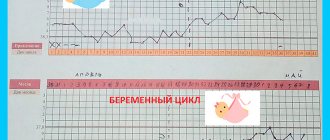Rectal temperature during early pregnancy
A pregnancy test sometimes fails, menstruation may also appear at an early stage, but the rectal temperature will accurately indicate whether conception has taken place.
Firstly, it will determine whether a woman is pregnant or not, and secondly, it will identify complications in the early stages. In this article we will try to find out what rectal temperature should be during pregnancy. During the menstrual cycle, hormone levels change. Accordingly, the basal temperature - the temperature of the internal organs, which is measured in the vagina - also changes. It is believed that true indicators can be obtained if the temperature is measured in the rectum. We are talking about rectal temperature.
Measurements usually give a graph like this:
- temperature is slightly less than 37 degrees during the period: the first day of menstruation - the beginning of ovulation;
- the temperature rises by half a degree or more (up to 37.3) during ovulation and the second half of the cycle;
- before the start of a new cycle, the temperature drops again to 36.9.
During early pregnancy, the rectal temperature remains elevated throughout the second half of the cycle (37.1–37.3). It is these data that indicate that conception has occurred. Progesterone began to be intensively formed in the woman’s body. It is he who maintains the temperature.
What other types of rectal temperature occur during pregnancy? In some cases it can reach 38 degrees. As a rule, the temperature does not go higher. But it’s still worth getting examined: if it’s elevated, then this may indicate inflammatory processes.
Low rectal temperature during pregnancy (up to 37 degrees) is a more alarming sign for the woman and the fetus. This may indicate a threat of miscarriage or fetal fading, so you need to rush to the doctor. Gynecologists insist on taking rectal temperature readings for women who have already had an unintentional termination of pregnancy.
This is the easiest way to determine pregnancy. But in order to obtain accurate data on the temperature of internal organs, you need to follow some rules, which will be discussed below.
How to measure rectal temperature?
It is worth considering that an elevated temperature may persist due to other factors - not only due to conception. Typically this is:
- a disease that causes high fever;
- any physical action before measuring temperature, even getting out of bed;
- sleep duration is less than six hours;
- the break between measuring temperature and having sex is less than 12 hours;
- eating before the procedure;
- taking certain medications.
So, let's move on to the process of measuring rectal temperature during early pregnancy. The procedure must be carried out in the morning, as soon as you wake up.
It is strictly forbidden to get out of bed before the measurement, shake off the thermometer, it is not even recommended to talk - remember that even minor movements affect the accuracy of the result. Therefore, in the evening you need to prepare a thermometer, baby cream, and a watch and, for convenience, put them near the bed.
In the morning, lubricate the tip of the thermometer with cream and insert it 2-3 cm into the anus. The procedure itself lasts 7 minutes. Then we look at the result. We hope he made you happy!
Remember that normal rectal temperature during pregnancy does not guarantee successful pregnancy, but will help prevent miscarriage at an early stage.
Thus, we found out how to determine pregnancy by rectal temperature. This method, of course, is old and creates some inconvenience for the woman, but it is time-tested. Therefore, if a doctor has prescribed such a procedure for you, be sure to follow his instructions.
| Signs of pregnancy in the early stages before delay Pregnancy, especially when it is expected and planned, is always an extraordinary joy for expectant parents. Then they want to see the symptoms of pregnancy without waiting for a delay. Next, consider probable and reliable signs, as well as warning signs that could overshadow the event. | Discharge in the early stages of pregnancy before menstruation Often in the early stages of pregnancy, women notice discharge just at the time when their menstruation should have started. There are several reasons for this phenomenon; let’s take a closer look at why this happens. Read about this further in our article. |
| Blood test for early pregnancy Many girls have heard that you can reliably find out about the fact of pregnancy by taking a blood test. However, not everyone knows what it is called, mistakenly believing that conception can be determined through a general analysis. Next, we will tell you what kind of test can show whether you are pregnant or not. | The first week of pregnancy - signs and sensations When pregnancy is desired and long expected, a woman from the first days tries to look for even the slightest manifestations of her new condition, wanting to find confirmation of her expectations. Let's discuss whether signs of conception can appear in the first week. |
Source: https://womanadvice.ru/rektalnaya-temperatura-pri-beremennosti-na-rannih-srokah
Method of measurement and contraindications
Anal temperature is measured with a mercury thermometer with the patient in the lateral position with the hips adducted to the abdominal wall. Before insertion into the anal canal, the rectal thermometer is rinsed from the disinfectant solution with running water, then wiped dry and shaken so that the mercury column drops below 35 ° C. Then its end is lubricated with petroleum jelly or vegetable oil and inserted to a depth of 5 cm, leaving it in a straight line intestines for 5 minutes. After inserting the thermometer, the buttocks must be tightly squeezed around it. After 5 minutes, it is removed and the result of thermometry is recorded.
When assessing the result, it is necessary to take into account that the normal value can be from 0.5 to 1 ° C above the temperature measured in the armpit. Thus, the normal temperature measured rectally is 37.3 - 37.7 35 ° C.
Measuring rectal temperature is contraindicated in cases of stool retention, when there is dense stool in the intestine, diarrhea, and various diseases of the rectum in their acute phase, such as hemorrhoids, proctitis and some others.
What can you tell from the temperature in the anus of a pregnant woman?
Many people were concerned about the information that temperature can be an indicator of pregnancy, but not everyone understands what’s what. In the meantime, assessing what the temperature should be during ovulation or pregnancy is a good indicator of many processes in the female body.
Early signs of pregnancy
It is customary to identify several main signs of pregnancy, which are considered early and which are difficult for the expectant mother to ignore. These include:
- nausea, which, however, does not manifest itself in all women, since many are completely freed from the concept of early toxicosis;
- the general temperature of the case should be slightly elevated, as if with a mild cold - chills and weakness may also be present;
- nervousness appears, mood is difficult to control due to rapid hormonal changes;
- drowsiness appears, which can accompany a woman throughout pregnancy, and which is best dealt with through frequent ventilation;
- many women in the early stages of pregnancy complain of mild pain in the lower abdomen, which is accompanied by spotting;
- a characteristic sign is also chest pain, which, however, is not an accurate sign, since for many women it also appears during the period of ovulation;
- the urge to urinate may become more frequent;
- often evidence of pregnancy can be a decrease or increase in libido, although the increase is more typical for ovulation processes;
- Delayed menstruation is the most obvious and most widely known symptom.
Basal rates - what are they?
Basal temperature is the value that can be obtained from measurements taken in the mouth, vagina or anus of a woman.
Many women, by making these measurements, can guess on what day sex is safe and when there is a high risk of becoming pregnant.
Basal temperature is an indicator of the phase of the menstrual cycle, as it can change under the influence of hormonal levels.
So what temperature should a woman have in different phases?
Before your period
Before menstruation, it is noted that the basal temperature decreases slightly compared to its usual values.
What exactly should the temperature be? It is impossible to give exact values, since this indicator is individual for each woman and all that needs to be done is to observe the changes in your own body over a couple of cycles. Thus, a woman will be able to clearly establish what the temperature should be before menstruation.
Before ovulation
Basal temperature during ovulation is not set at one specific point.
It is necessary to draw conclusions about it based on drawing up a schedule.
However, it is worth keeping in mind that during the period of ovulation it will always be slightly higher than usual.
To calculate ovulation, it is recommended to follow simple rules: from the beginning of menstruation in the morning, measurements begin. It is recommended to follow the regime, repeating the procedure every day at the same time.
Then a graph is drawn up in which the temperature for each day is entered. If you carefully analyze the chart, the moment the indicators rise will be obvious, and this can be considered the day of the beginning of ovulation.
During pregnancy
Basal temperature readings can be a very clear indicator of pregnancy, but for this, a woman must regularly keep a temperature chart and be well aware of her own menstrual cycle.
Most often, a stable increase of more than 37 degrees indicates pregnancy, but the basal temperature may remain low. This usually happens when there is a threat of miscarriage.
Focusing on the basal rate during pregnancy is most often irrational; it is easier to visit a gynecologist who will definitely stop the fact of pregnancy.
Measurement Rules
When ovulating, before menstruation, or if you suspect pregnancy, you must follow a number of rules that will help you get the most reliable results.
These include:
- Before measurement, you must sleep at least 4 hours;
- before the procedure you cannot even get out of bed, since physical activity, even minimal, will make the measurement unreliable;
- To be sure, it is recommended to take a break from having sex for at least 12 hours;
- Eating before measuring temperature is also prohibited, since nutrition is equated to physical activity, and therefore also distorts the results;
- to obtain reliable data you will have to stop taking certain medications;
- the procedure will not give reliable results if the woman is sick.
Pros and cons of the technique
During pregnancy, menstruation or ovulation, the method of measuring basal temperature is effective, but still has a number of significant disadvantages:
- you need to be diligent in keeping notes daily;
- there is a need to follow a routine, always getting up at the same time;
- during ovulation it is not always possible to accurately determine basal temperature;
- the technique becomes ineffective for any disease that is accompanied by a jump in temperature;
- To ensure the reliability of the results, women should not drink alcohol, otherwise the graph will be distorted.
On the other hand, the technique has a number of significant advantages:
- You can even use it at home;
- the procedure does not take a lot of time;
- the method itself is very simple;
- nothing threatens women's health;
- there is no need for additional expenses;
- You don’t have to see a doctor if there is no cause for concern;
- it becomes possible to plan a pregnancy.
It is worth keeping in mind that a huge number of factors influence the basal temperature during ovulation or pregnancy, so if a woman notices any deviations from the norm, she must make a note about it in her diary.
The method of diagnosing pregnancy by measuring basal temperatures, although it requires perseverance, is very reliable, especially if done on the recommendation of a doctor.
Conquered hemorrhoids at home. It's been a month since I forgot about my bumps. Oh, what methods I tried - nothing helped. How many times did I go to the doctors, but they prescribed me useless medications over and over again, and when I returned, the doctors recommended surgery. Finally, I overcame the disease, and all thanks to this article. Anyone with hemorrhoids should read this!
Read the full article>>>
4,20 (: 5
Source: https://DrGemor.ru/pri-beremennosti/temperatura-v-zadnem-proxode.html
What is the temperature during pregnancy in the anus in the first week
A pregnancy test sometimes fails, menstruation may also appear at an early stage, but the rectal temperature will accurately indicate whether conception has taken place. Firstly, it will determine whether a woman is pregnant or not, and secondly, it will identify complications in the early stages. In this article we will try to find out what rectal temperature should be during pregnancy.
During the menstrual cycle, hormone levels change. Accordingly, the basal temperature - the temperature of the internal organs, which is measured in the vagina - also changes. It is believed that true indicators can be obtained if the temperature is measured in the rectum. We are talking about rectal temperature.
Measurements usually give a graph like this:
- temperature is slightly less than 37 degrees during the period: the first day of menstruation - the beginning of ovulation;
- the temperature rises by half a degree or more (up to 37.3) during ovulation and the second half of the cycle;
- before the start of a new cycle, the temperature drops again to 36.9.
During early pregnancy, the rectal temperature remains elevated throughout the second half of the cycle (37.1–37.3). It is these data that indicate that conception has occurred. Progesterone began to be intensively formed in the woman’s body. It is he who maintains the temperature.
What other types of rectal temperature occur during pregnancy? In some cases it can reach 38 degrees. As a rule, the temperature does not go higher. But it’s still worth getting examined: if it’s elevated, then this may indicate inflammatory processes.
Low rectal temperature during pregnancy (up to 37 degrees) is a more alarming sign for the woman and the fetus. This may indicate a threat of miscarriage or fetal fading, so you need to rush to the doctor. Gynecologists insist on taking rectal temperature readings for women who have already had an unintentional termination of pregnancy.
This is the easiest way to determine pregnancy. But in order to obtain accurate data on the temperature of internal organs, you need to follow some rules, which will be discussed below.
How to measure rectal temperature?
It is worth considering that an elevated temperature may persist due to other factors - not only due to conception. Typically this is:
- a disease that causes high fever;
- any physical action before measuring temperature, even getting out of bed;
- sleep duration is less than six hours;
- the break between measuring temperature and having sex is less than 12 hours;
- eating before the procedure;
- taking certain medications.
So, let's move on to the process of measuring rectal temperature during early pregnancy. The procedure must be carried out in the morning, as soon as you wake up.
It is strictly forbidden to get out of bed before the measurement, shake off the thermometer, it is not even recommended to talk - remember that even minor movements affect the accuracy of the result. Therefore, in the evening you need to prepare a thermometer, baby cream, and a watch and, for convenience, put them near the bed.
In the morning, lubricate the tip of the thermometer with cream and insert it 2-3 cm into the anus. The procedure itself lasts 7 minutes. Then we look at the result. We hope he made you happy!
Remember that normal rectal temperature during pregnancy does not guarantee successful pregnancy, but will help prevent miscarriage at an early stage.
Thus, we found out how to determine pregnancy by rectal temperature. This method, of course, is old and creates some inconvenience for the woman, but it is time-tested. Therefore, if your doctor has prescribed such a procedure for you, be sure to follow his instructions.
source
Rectal temperature, first of all, becomes one of the most effective ways to determine the onset of pregnancy.
Sometimes tests are wrong, and discharge occurs even after fertilization, which can mislead a woman about a successful pregnancy.
But the rectal temperature will not deceive - its increased readings for three days in the absence of menstruation categorically indicate that fertilization has occurred.
Rectal temperature is measured in the rectum. And in the first 20 weeks of pregnancy, its indicator will be about 37 degrees and slightly higher. This situation is explained by the fact that in the first weeks of pregnancy, the processes occurring in a woman’s body regulate the hormones of the second half of the menstrual cycle.
Women who have dealt with charting basal, in particular, rectal temperature, know: before the onset of ovulation, approximately until the middle of the menstrual cycle, the rectal temperature is below 37 degrees.
After the indicators increase by about half a degree, we can talk about the onset of ovulation. In this case, the elevated rectal temperature persists throughout the entire second half of the cycle.
If pregnancy has taken place, the elevated rectal temperature remains due to hormonal regulation.
Despite the fact that modern examination methods make it possible to do without measuring rectal temperature during pregnancy, in some cases doctors prescribe such procedures to expectant mothers.
They will be especially important for women who have previously had miscarriages: a decrease in rectal temperature becomes an alarming sign, indicating an existing threat of miscarriage. Therefore, if a decrease in rectal temperature is observed when measuring rectal temperature during pregnancy, you should immediately consult a doctor for advice.
The same applies to increased rectal temperature: if its indicator is increased to 37.6-37.8 degrees, this is a serious reason for additional examinations. Thus, increased rectal temperature during pregnancy may indicate the occurrence of inflammatory processes in the body.
And, nevertheless, women who have not previously experienced miscarriage should not worry too much when measuring rectal temperature at 36.9 degrees: each organism is unique, and fluctuations of 1-2 degrees are quite acceptable.
In order to get the most accurate readings, rectal temperature is measured in the morning, immediately after waking up, without getting out of bed. It is advisable to place a thermometer nearby in the evening, having previously knocked down the previous readings.
Doctors also do not recommend not only not getting out of bed before measuring rectal temperature, but not even opening your eyes or talking - sudden movements, bright rays, and indeed any actions can affect the result.
It is best to measure rectal temperature during pregnancy at the same time, with the same thermometer. If you had to wake up earlier than usual, for example, to go to the toilet, it is still better to measure your rectal temperature before getting up.
Rectal temperature is measured to obtain the necessary information about the course of pregnancy until 16-20 weeks - after this period the temperature drops, and its measurements will not be informative.
A decreased rectal temperature during pregnancy becomes a compelling argument for seeing a doctor: a decrease below 37 degrees may indicate a threat of failure, and, in addition, a risk of stopping the development of the fetus. All this becomes the result of hormonal changes, which can be determined by regularly measuring rectal temperature.
source
Many women cannot understand the difference between rectal temperature and basal temperature. The first is measured only in the rectum, while the second can be measured in the mouth and vagina. But the most accurate measurements are obtained only in the rectum.
At all stages of the menstrual cycle, the level of hormones that influence temperature changes. Measuring it daily and recording it on a graph, a woman can use the fluctuation graph to:
- Accurately see the phase of the monthly cycle, and see deviations from the norm
- Calculate the most favorable days suitable for conceiving a child, at this time ovulation begins, and t rises to 37.2.
- Calculate the time when sex becomes safe.
- Find out about pregnancy; in its early stages, anal temperature does not decrease after menstruation for 18 days.
For each woman, the rectal temperature during pregnancy mainly depends on the individual characteristics of her body. But there are still its average indicators: after conception it ranges from 37.1 – 37.5; in some women it even reaches 38; if it is higher, this is not a symptom of pregnancy, but of a disease.
If the temperature is below average, this may indicate that something is threatening the pregnancy. The production of pregnancy hormones has stopped, so the fetus is frozen. If the temperature does not increase, the doctor takes timely measures.
To obtain accurate data, you need to know how to correctly measure rectal temperature during pregnancy. It is measured only in the rectum, in the morning after waking up. You cannot insert a thermometer into the vagina. Every day this must be done at the exact time and the readings recorded. The thermometer should be prepared in the evening so as not to get out of bed.
If there are any changes in the routine, or the pregnant woman often wakes up and gets out of bed at night, she should note this in her notes. Can lead to increased temperature and sexual intercourse. This also needs to be noted in a separate column.
To make measurements accurate, you must:
- Before going to bed, place a thermometer, preferably mercury, a watch and baby cream next to the bed;
- In the morning after waking up, take a thermometer without getting out of bed and lubricate its tip with cream
- Carefully insert the tip of the degree into the anal passage; it should enter two to three centimeters; it cannot be measured in the vagina.
- After seven minutes, take out a thermometer and check the result.
There are also other points that affect the exact results, they also need to be taken into account:
- To ensure accurate readings, you need to sleep for at least 4 hours before taking measurements.
- No physical activity until it is measured, the toilet must wait.
- At least 12 hours should pass before measuring your temperature after sex.
- There should be no snacks, even light ones, before the measurement. Some women suffering from early toxicosis are accustomed to eating after waking up to get rid of nausea. But if this is done before measuring the temperature, the results will be incorrect.
- The result is greatly influenced by the use of medications.
- In case of infectious and colds, the overall body temperature may increase, so measurements should be stopped at this time.
This method is old, labor-intensive, and very time-consuming. No quick conclusions can be drawn here. It is necessary to constantly measure the temperature daily for three menstrual cycles. For a more complete picture, a woman should also note in her chart the nature of the vaginal discharge.
Simpler and more accurate methods for determining pregnancy and diagnosing it have now been developed. But some doctors still prefer this diagnostic method to assess the hormonal state of the body. This way they can determine possible causes of infertility. Therefore, it is better to listen to and implement their recommendations.
Only a doctor evaluates the chart data. The woman must submit her schedule to him. This method is quite cheap and reliably determines whether there are enough hormones in the blood.
Hello, dear future mothers and fathers! Carefully preparing to become parents forces you to learn and study as much information as possible about pregnancy.
You may have already heard that basal or rectal temperature readings can indicate pregnancy.
In addition, basal temperature during pregnancy allows you to diagnose the course of pregnancy and identify problems in the early stages.
If not, and don’t even know what it is, this material will come in handy for you. We will try to explain to you in an accessible and understandable way how to correctly measure this temperature, what temperature would be normal during pregnancy, and why such measurements should be taken?
If temperature measurements are taken in the rectum (lat. rectum), then they say that this is rectal temperature. Basal (baseline) temperature can be measured orally, in the vagina, and also in the rectum.
The most accurate measurements will be in the rectum, therefore, when we say basal temperature in pregnant women, we will mean rectal. So, we hope that we have understood the concepts and their application, now we move on.
Basal temperature: why do you need to measure it?
During all stages of menstruation, women experience changes in the levels of certain hormones. It is these hormones that influence changes in basal temperature.
This means that with the help of daily measurements you can:
- determine the most favorable days for trying to conceive, since on the days of ovulation the temperature rises to 37.2;
- determine the onset of pregnancy: it is known that the basal temperature in the early stages of pregnancy will not decrease more than 18 days after menstruation;
- diagnose how pregnancy is progressing.
Source: https://historyam.ru/nedeli-beremennosti/kakaya-temperatura-pri-beremennosti-v-zadnem-prohode-v-pervuyu-nedelyu/
How to measure basal temperature correctly
In order for measurements to be reliable, they must be carried out in the morning. The fact is that during the day the basal temperature (as well as the general body temperature) changes, this is influenced by physical activity, stressful situations, food and medications consumed, overheating or hypothermia, and many other factors. In order for the measurement results to be informative and reliable, you must adhere to a few simple rules:
- It is pointless to measure BT while consuming alcohol, oral hormonal contraceptives and sedatives. All of them are capable of increasing the temperature of the rectum, making the measurement results uninformative.
- Rectal temperature is measured in the rectum by inserting a thermometer into the anus. Measuring in the mouth or vagina is prohibited.
- In order to determine normal individual basal body temperature, measurements must begin on the first day of the menstrual cycle, after 5-6 hours of sleep.
Measuring basal temperature is very important not only when planning pregnancy or bearing a child, but also in ordinary women’s life. After all, any minor fluctuations unforeseen by the cycle, even 0.2 degrees, will make it possible to detect the development of possible diseases or pathologies of the woman’s genitourinary system in the early stages. And this is very good, since any diseases in the early stages are treated much faster and easier.
The menstrual cycle in women can be short (regular) or long, while the first (follicular) phase is different for everyone, but the duration of the second (luteal) phase is approximately the same, from 12 to 14 days. That is why, if after a temperature change (ovulation) the basal temperature remains elevated for 14 days, then if there are any additional symptoms, pregnancy can be safely stated.
Early signs of pregnancy
Early signs of pregnancy appear from the very beginning of a missed period, approximately 14-20 days after conception. It is thanks to them that ladies rush to antenatal clinics to confirm or refute their hopes/fears.
How can you independently diagnose your interesting situation? What early signs of pregnancy are considered the most reliable? In order to understand this issue, let's mentally divide the most common symptoms into those felt by the expectant mother and those not felt, but actually occurring changes in the body.
What does the expectant mother feel and notice?
1. Mild nausea.
Yes, usually just mild; at such an early stage, toxicosis does not yet have time to develop to its full extent. However, many women do not experience any such unpleasant sensations at all, not immediately after conception or after a few weeks.
Nausea usually appears early in the morning, immediately after waking up. The best way to deal with this unpleasant condition is a proper diet, exclusion and replacement with similar foods that cause attacks of nausea and (or) vomiting.
In some cases, women, on the contrary, develop a good appetite.
2
.
As a rule, early signs of pregnancy temperature
. As you know, subfebrile values - 37-37.5 degrees - are the most unpleasant. Slight chills, fatigue - you can get rid of this not only with medications, but also with not particularly long walks in the clean air.
3. Nervous state.
The expectant mother, as a rule, has difficulty controlling her emotions. May lash out at loved ones for no reason. Suddenly you start to cry or start screaming. However, this phenomenon is also expressed in different strengths in different women.
4. Drowsiness.
These early signs of pregnancy persist throughout the entire period of pregnancy.
If you constantly want to sleep, then the first thing you need to do is walk outside more often and do non-boring things, maybe find some new hobby. The room should not be stuffy, the temperature and humidity in the room should be comfortable.
Ventilate the room often. It would also not hurt to take a blood test and measure your blood pressure. Drowsiness can be caused by low hemoglobin or low blood pressure.
5. Pain in the lower abdomen.
In the first days of the delay, most mothers cannot shake the feeling that their period is about to begin. The culprit is nagging pain in the lower abdomen.
If pain is felt for several days in a row, but there is still no menstruation, then this phenomenon can be perceived as an early sign of pregnancy; meanwhile, spotting and bloody discharge should be absent.
The abdomen normally hurts in the first weeks due to hormonal changes, later due to the growth of the uterus or its tone.
6. Pain in the mammary glands.
In the first weeks of pregnancy, it is not much different from the pain that many women experience at the end of each menstrual cycle. Feeling of heaviness, fullness of the chest, increased sensitivity of the nipples.
If the pain is not concentrated in any specific point of the mammary gland, and both breasts hurt, then these are early signs of pregnancy. If the pain is localized in a certain area, some pathology can be suspected, for example, breast fibroadenoma.
It is necessary, at a minimum, to palpate the mammary glands yourself, and if the pain persists, and during self-examination you feel something unusual - some kind of mass formation - you need to tell the doctor about it and do an ultrasound of the mammary glands.
In very rare cases, colostrum may be released from the nipples in early pregnancy.
7. Frequent urination.
The appearance of this symptom over a short period of time is caused by the hormone progesterone, which somewhat relaxes the bladder sphincter. Over long periods of time, frequent urination is associated with pressure from the uterus on the bladder.
8. There are very ambiguous early signs of pregnancy: discharge
, say, may indicate the beginning of a new life and not be a sign of a threat of interruption and vice versa.
But spotting, as a rule, still signals that it is time to urgently consult a doctor if you plan to keep the child.
The discharge, which is clear, odorless and not accompanied by pain in the lower abdomen, should not cause concern. This phenomenon is normal.
9. Increased or, conversely, decreased libido.
It's different for everyone. On the one hand, hormonal changes contribute to a decrease in libido. Nature thus seems to take care of the health and preservation of the life of the fetus. On the other hand, blood flow in the genital area increases.
10. Delayed menstruation.
The last sign on this list, but not the last one for diagnosis. It is the delay that is the first, most reliable early sign of pregnancy for a woman; not everyone measures their basal temperature and not everyone does a test before the delay begins.
However, not only expectant mothers may miss menstruation. Secondary amenorrhea occurs in very thin women, lovers of super-low-calorie diets, and simply poor nutrition. When a woman's body receives few nutrients, the production of the female hormone estrogen is also reduced, which leads to a lack of monthly bleeding.
Menstruation can be delayed in very young girls with a not yet established menstrual cycle, in those who are breastfeeding, due to severe stress, taking certain medications, etc.
What is the reason for the increase?
The temperature of a pregnant woman is affected by hormonal levels and changes in thermoregulation processes. In the first trimester, expectant mothers feel unwell and feverish. If there are no other negative signs, the condition is considered adequate.
Normal temperatures may rise slightly in early pregnancy.
This is a consequence of an increase in the production of the hormone progesterone, which is responsible for preserving the fetus. In general, the woman feels fine. Often, a weakened immune system also leads to an increase in temperature. It poses no danger to either the mother or the child.
But in some cases, high temperature in early pregnancy can be caused by intestinal or genitourinary infection, acute respiratory viral infection and other diseases.
In this case, the temperature reaches 38-38.5 °C, and other symptoms appear: cough, runny nose, swollen lymph nodes, headaches, pain in the sacrum, rash, etc.
- ARVI and inflammatory processes.
In addition to the elevated temperature, there is a cough, severe pain in the head and throat, and a runny nose. ARVI can lead to pneumonia, tracheitis, otitis.
These are serious complications that can affect the development of the fetus.
Its intrauterine infection will become inevitable if treatment is not started in a timely manner. In some cases, fetal malformations appear.
If symptoms of stool disorder and fever are observed, this indicates an infectious disease that may require treatment in a hospital.
- Diseases of the genitourinary system.
Pyelonephritis and cystitis are also accompanied by chills, painful urination, general intoxication and nagging pain in the lower back. Pyelonephritis is a serious disease that can lead to termination of pregnancy.
- Other infectious diseases.
In the early stages of gestation, there is a high probability of developing smallpox, measles or rubella. In this case, the temperature reaches 38.5 °C, and rashes appear on the skin.
Ectopic pregnancy can also be attributed to the causes of increased body temperature.
The danger of fever in the first trimester
Temperature increase is a protective reaction of the body, but in the initial stages it can lead to irreversible consequences. In the first trimester, there is an active process of formation of the internal organs of the unborn baby. In the first time after fertilization, the formation of the nervous, digestive and cardiovascular systems occurs. Rising temperatures pose the following dangers:
- The occurrence of developmental defects in a child in the jaw, lips, palate, and eyeballs.
- Protein synthesis is disrupted, which leads to a decrease in blood supply to the placenta. This is fraught with a lag in the development of the child’s brain activity.
- Early placental abruption and increased tone can lead to premature birth.
- Intoxication of the body leads to pathology in the functioning of the cardiovascular system.
- The frequency of contraction of the uterine muscles increases, which can lead to termination of pregnancy.
- The occurrence of blood clots that clog the blood vessels of the placenta can provoke a miscarriage.
- Toxicosis occurring in severe form.
- Increased uterine tone.
All of the above dangers pose a real threat to the development and life of the fetus and the health of the expectant mother. It is important to consult a doctor promptly to diagnose the cause of the fever and begin proper treatment.
How to cope with a high temperature in early pregnancy
You can lower your body temperature with the help of medications, as well as traditional medicine.
Medications
It is necessary to show concern about the temperature after the thermometer reaches 38 °C.
If such a manifestation is accompanied by other negative symptoms, treatment should be undertaken.
In such cases, medications are prescribed. But before taking it, you need to visit a doctor, since many of them can have a detrimental effect on the health of the expectant mother and fetus.
Basic rules for prescribing medications for fever in the first trimester:
- Antipyretic tablets can only be prescribed at temperatures above 38 °C.
- Doctors often prescribe the simultaneous use of several drugs. It is possible to use antibiotics, for example, for pyelonephritis.
- The doctor can prescribe vitamin complexes and drugs that increase the level of immunity, for example, Viferon.
- In exceptional cases, it is possible to take medications that are not indicated during pregnancy. They are taken according to strict medical instructions.
Taking medications that include paracetamol is considered the most effective and safest at the initial stage of pregnancy. But it should not be taken more than four times a day because it is hard on the liver if used for a long time.
Homeopathic antipyretics, such as plant-based Viburkol with rectal administration, can be used.
Ibuprofen, aspirin, indomethacin - these components can adversely affect the condition of the fetus and have a significant number of side effects. For example, aspirin affects blood clotting and may cause breakthrough bleeding.










